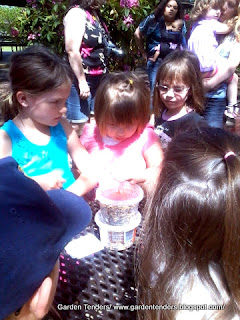 Five Little Ladybugs
Five Little Ladybugs
One flew away and then there were four.
Ladybug, ladybug fly fly away.
Four little ladybugs sitting in a tree.
One flew away and then there were three.
Ladybug, ladybug happy all day.
Ladybug, ladybug fly fly away.
One flew away and then there were two.
Ladybug, ladybug fly fly away.
One flew away and then there was one.
Ladybug, ladybug fly fly away.
One flew away and then there was none.
 Yep, this week we learned about Ladybugs. It was prompted by a ladybug release our homeschool group did in a local park. Ladybugs are beloved by us all though.
Yep, this week we learned about Ladybugs. It was prompted by a ladybug release our homeschool group did in a local park. Ladybugs are beloved by us all though.You can buy ladybugs yourself and release them as well in your garden. They are amazing little creatures and I plan to buy some when Bear's cousins are visiting and allow the girls to release them together in the garden. Check your local nursery's. Locally you can check Windmill Nursery in Sumner, WA, Marlene's Health Market in Tacoma, or the Home and Garden section at Fred Meyers. I would also contact any more reputable nursery near your home, odds are they will have them. They are good garden bugs, so don't worry. (From a friend--Release them at dusk for better retention in your yard).
Some of the facts we learned about lady bugs this week:
- Ladybugs are related to beetles. Beetles and ladybugs are insects.
- Ladybugs are considered good luck.
- Ladybugs come in many colors--yellow, orange, pink, and red. Some ladybugs are black with red spots. Some have no spots at all.
- Birds don't eat ladybugs because their bright colors are a warning that they don't taste good.
- Ladybugs use their feet to smell. Do you use your feet to smell?
- Ladybugs have sticky feet too. Do you ever have sticky feet?
- Ladybugs like to form large groups, like families. It helps to keep them warm, according to scientists.
- Ladybugs experience four stages of growth. --Like other insects, ladybugs will go through four stages. They are egg, larva, pupa and adult ladybug.
- Ladybugs can fly about 15 miles per hour. --The highest speed of most ladybugs is about 15 miles per hour. That is much slower than other insects. (Some dragonflies can fly 60 miles per hour).
- Ladybugs hibernate. -- During the winter, when it is very cold, ladybugs will hibernate. That means they rest until it gets warmer.
- A female/girl ladybug will lay more than 1000 eggs in her lifetime.
- Aphids are a ladybug's favorite food.
After we released the ladybugs our homeschool group ate lunch, played in the park and went on a nice walk around the lake were we seen baby ducks. The learning continues the rest of the week with looking at our own garden bugs and exploring books and learning sounds, using a magnetic alphabet set as help/guides.
 |
| after the lady bug release we went for a walk around the lake and seen baby ducks with their mommy. |





No comments:
Post a Comment
Thank you for taking a few moments to share your comments with me. It means a lot. Thank you!